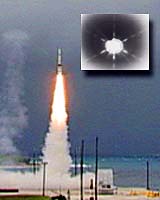| . |  |
. |
 Missile Interceptor Easily Fixed
Missile Interceptor Easily Fixedby Jim Mannion Washington (AFP) February 8, 2000 - An easy-to-fix leak in a coolant pipe appears to have caused a missile interceptor to miss its target last month in a test of the National Missile Defense (NMD) system, a Pentagon official said Tuesday. The attempted interception of a dummy warhead over the Pacific January 18 failed in the last six seconds when the interceptor's two infrared seekers shut down, essentially blinding it as it closed in for the kill. Investigators have determined that a leak in a pipe that carries nitrogen gas to a coolant system caused the interceptor's infrared sensors to overheat, said the official, who spoke on condition of anonymity. "We still have more than a month (of analysis) to do, but the leak in the nitrogen line that goes through the cooling system is undoubtedly a factor," the official said. The official said that to date, no other problems have been detected with the NMD system which maneuvered a 120-pound "kill vehicle" from a Pacific atoll to within 100 feet of the dummy warhead that had been launched on a missile from California. The near miss followed a successful, although more limited, test in October. The official said fixing the leaky pipe is "not difficult at all. We had no problem with it in the other two flights of the Raytheon kill vehicle." "What we'll do for the next test to make sure is we'll have more pressurization tests, more inspections and hopefully solve that particular problem," he said. The system, which is designed to protect all 50 US states against a limited ballistic missile attack by a rogue state, is opposed by Russia, China and some US allies. But President Bill Clinton is supposed to decide this summer whether to order the deployment of the system by 2005. That timetable has raised the stakes for the next attempted interception, the last before the presidential decision and one that will determine whether the Pentagon urges the system's deployment or recommends that a decision be delayed. Although still scheduled for late April or early May, the test may be delayed for several weeks to be sure the system is ready to go, the Pentagon official said. The general in charge "is not going to conduct the next test until he is fully confident the problem has been taken care of," the official said. The "kill vehicles" are destroyed in the intercept attempts, so the cause of last month's failure had to be deduced from the massive amounts of telemetry data generated during the test. "You can tell how a certain component performed based upon that telemetry. You can tell sensors were overheated and weren't cooled," he said. "Based upon that you can isolate the fact it was cooling problem." The telemetry data also showed that the "kill vehicle" was rotating more than it should have as it closed on the dummy warhead, he said. From that experts concluded that a gas leak was acting as a tiny jet, he said.
MILSPACE
|
| |||||||||
| The content herein, unless otherwise known to be public domain, are Copyright 1995-2016 - Space Media Network. All websites are published in Australia and are solely subject to Australian law and governed by Fair Use principals for news reporting and research purposes. AFP, UPI and IANS news wire stories are copyright Agence France-Presse, United Press International and Indo-Asia News Service. ESA news reports are copyright European Space Agency. All NASA sourced material is public domain. Additional copyrights may apply in whole or part to other bona fide parties. Advertising does not imply endorsement, agreement or approval of any opinions, statements or information provided by Space Media Network on any Web page published or hosted by Space Media Network. Privacy Statement All images and articles appearing on Space Media Network have been edited or digitally altered in some way. Any requests to remove copyright material will be acted upon in a timely and appropriate manner. Any attempt to extort money from Space Media Network will be ignored and reported to Australian Law Enforcement Agencies as a potential case of financial fraud involving the use of a telephonic carriage device or postal service. |